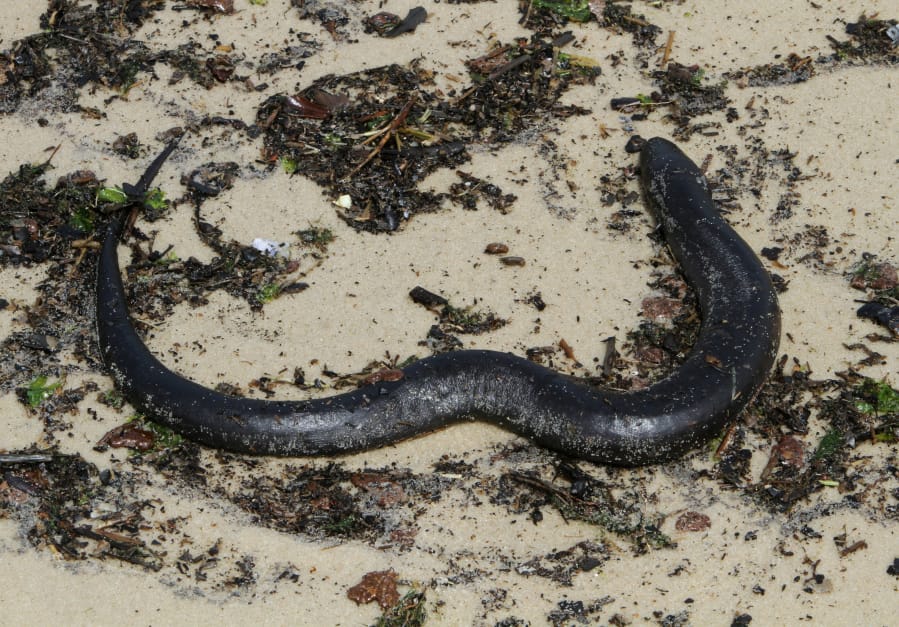RALEIGH, N.C. — American eels are slimy, sinuous creatures that slither their slender, scaled bodies through water both fresh and salty.
But not much is known about this elusive eel, found in nearly every aquatic habitat in North Carolina — from the cold mountain streams and lakes of the Smoky Mountains to the marshes of the Outer Banks and beyond.
Lewis C. Naisbett-Jones, a Ph.D. student at the University of North Carolina at Chapel Hill, is working at the UNC Institute of Marine Sciences in Morehead City to change that.
The American eel is a mysterious creature, Naisbett-Jones told The News & Observer in an interview. The snakelike creatures annually travel thousands of miles across featureless Atlantic Ocean depths of more than 6,500 feet in complete darkness in order to breed, but no one knows how they accomplish this feat.
“Not only do we not know where it is they go, we still don’t know how they accomplish this journey,” Naisbett-Jones said. “Unlike humans, they don’t have a GPS to guide them and the ocean has very few signposts.”
No one has ever witnessed eels spawning in the wild, nor have eel eggs ever been collected.
“I think in this day and age there are very few species as widespread as eels that we know so little about,” he said.
Naisbett-Jones is researching whether adult eels use the Earth’s magnetic field to guide their journey, the same way research shows sea turtles and migratory birds can.
To conduct his experiments, Naisbett-Jones built a large magnetic coil he and his team use to create magnetic fields similar to those that exist at different locations in the ocean.
“By placing eels inside this coil, we can observe how they behave and see whether they use information from Earth’s magnetic field to navigate,” he said.
American eels have been on the decline in recent years, and no one knows exactly why, Naisbett-Jones said.
Population decline
Despite once being highly abundant, their future is “hanging in the balance,” he said. In some areas, eel populations have declined as much as 99 percent.
The International Union for the Conservation of Nature considers the American eel “endangered.”
“Earth’s magnetic field changes through time due to a natural phenomenon known as geomagnetic drift. This phenomenon may have contributed to the decline of American eel populations, making it harder for them to navigate,” Naisbett-Jones said. “We need to understand what magnetic fields are important to eels during their migrations before we can investigate how geomagnetic drift affects eels.”
And better understanding how eels use the Earth’s magnetic field could help better improve human navigational technology, too, he said, especially in areas where satellites are less effective.
Like many fisherman, Naisbett-Jones said he used to think of eels as “somewhat of a nuisance.” But he says they’re “underappreciated.”
“American eels undertake this incredibly long migration across vast expanses of featureless ocean,” he said. “This fascinated me, particularly from a navigational perspective and after realizing that we still don’t know how these eels achieve this journey.
“Who doesn’t like a good mystery?”
Naisbett-Jones shared some facts about American eels:
• Live about 15 years
• Can grow up to 3 feet long and weigh about 17 pounds (females are usually larger than males)
• Live in areas from Greenland to Venezuela
• Spend most of their life in freshwater or areas where fresh water and the ocean meet
• Travel thousands of miles across the Atlantic to mate and die
• Are born and then travel back to where their parents grew up, without ever having been there before
• Are one of few fish that can swim backward
• Are an important food source for animals including otters, turtles, larger fish and birds
Naisbett-Jones already showed during his master’s degree research in the U.K. that juvenile European eels, a cousin to American eels that also breed in the Atlantic, use the Earth’s magnetic field to navigate.
“Extending this research to American eels and adult eels in general is the next piece of the puzzle and that’s what I’m doing right now, although it’s too early to say what we’ve found yet,” he said.
Increasing understanding of how the eels navigate is essential to successfully managing eel fisheries, designing marine protected areas, restoring and protecting critical eel habitat and predicting how the eels will respond to stressors such as climate change, Naisbett-Jones said.
“I believe they have an incredible story to tell and that this is something that can help change their perception and encourage their conservation,” Naisbett-Jones said.



